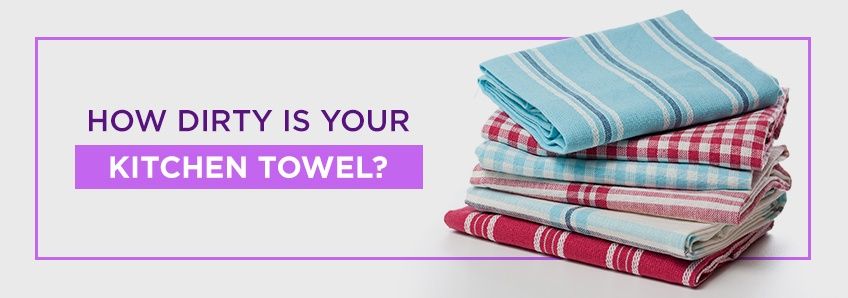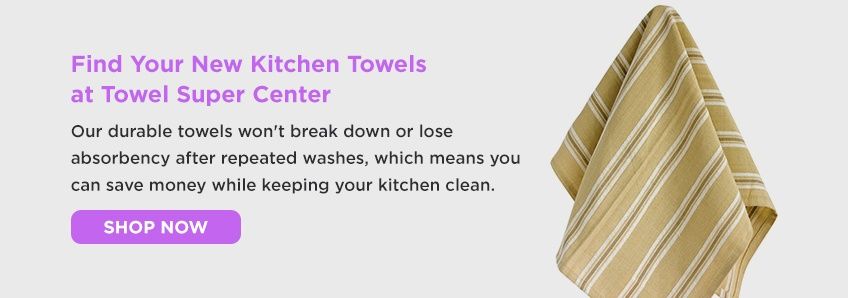How Dirty Is Your Kitchen Towel?
- Created: Tuesday, 26 November 2019 17:17
Kitchens are often a fast-paced environment filled with a flurry of activity at any given time. Between preparing meals, eating food and managing dirty dishes, most kitchens need cleaning after every use.
You know that unclean kitchen counters, stovetops and dishes pose a threat to your health. But what about dirty kitchen towels?
Though they may not be as obvious as a spaghetti-stained counter, kitchen towels can be some of the dirtiest items in your kitchen. Wet fabric in a warm kitchen is the perfect environment for invisible bacterial colonies to grow and multiply. With all this in mind, it's safe to assume your kitchen towel is much dirtier than you imagine.
What Makes Kitchen Towels Dirty?
The phrase "dirty kitchen towel" may call to mind images of food- or liquid-stained cloths. While visible dirt is a significant contributor to towel uncleanliness, so is invisible dirt. Bacteria is far less noticeable, yet it is one of the key players in how dirty kitchen towels are.
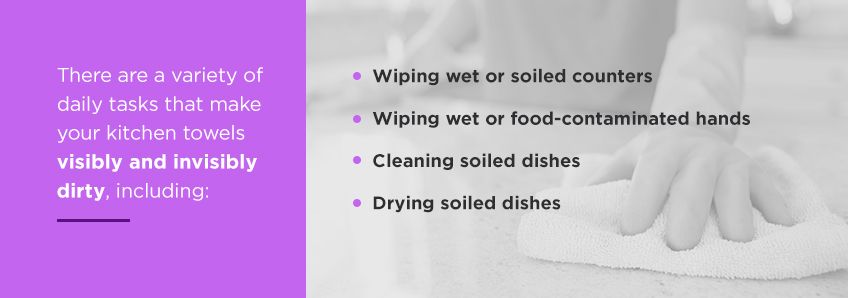
There are a variety of daily tasks that make your kitchen towels visibly and invisibly dirty, including:
- Wiping wet or soiled counters
- Wiping wet or food-contaminated hands
- Cleaning soiled dishes
- Drying soiled dishes
The degree of dirt on your towel is also influenced by how often you use it for those tasks. Decorative towels that you only use occasionally will have much less germ activity than an all-purpose towel that you use for all your kitchen needs.
If you're using one or two towels to do everything in your kitchen, you may run the risk of spreading bacteria around the room. Serious health issues can arise if you keep using dirty kitchen towels for a variety of tasks.
What Makes Kitchen Towels Dangerous?
When it comes to invisible dirt on kitchen towels, note that not all bacteria are the same. Some are harmless to individuals with healthy immune systems. Other bacteria will make you sick and contaminate the food you're preparing.
Most of the things that make kitchen towels dangerous are actions that we tend to complete without thinking twice.
These include actions such as:
- Wiping hands that have touched raw meat on a towel and later using that towel to wipe the counter dry
- Leaving a wet towel crumpled on the counter and not allowing it to dry out
- Using a kitchen towel for an extended period without changing it out or washing it
In the flow of preparing a meal, any one of these actions could happen. You're focused on the task at hand — not babysitting your towels. If your towel isn't visibly stained, you may not even recall touching raw meat and then using the towel on the counter the next day. Here lies the danger of dirty kitchen towels.
The Facts About Dirty Towels
A study conducted by researchers from the University of Mauritius found that germ growth on kitchen towels can potentially lead to illness and food poisoning if dirty towels are not properly removed from kitchen use soon enough.
Scientists collected 100 kitchen towels that had been used for a month and identified the type and number of bacteria present. Of the collected towels, 49 tested positive for bacterial growth. A selection of those towels were also growing staphylococcal (staph) and E. coli bacteria, which can cause food poisoning.
The study identified a few common factors among the towels that grew potential pathogens:
- Family size: If several people used a towel rather than one person, there was a higher chance the towel would have bacterial growth.
- Family members: When children were present, towels had a higher risk of bacteria from improper hygiene.
- Multipurpose use: Single towels used to dry hands, wipe utensils or counters and hold hot objects had higher bacteria counts than towels used for one purpose.
- Humid environments: Towels in humid areas that didn't dry properly showed a higher risk for E. coli bacteria.
- Non-vegetarian diet: Families who handled and ate meat, fish and eggs ran a higher risk of towel bacteria.
- Unhygienic practices: Families who didn't adhere to proper hand-washing or food-handling practices had a higher risk of towel bacteria.
Researchers concluded that those with children or elderly adults present should be especially careful about keeping towels clean. Dirty towels could lead to cross-contamination, which could be severe to an at-risk population.
Kitchen Practices to Protect Towels
The way you use towels in your kitchen affects your chances for bacteria. Ultimately, even those who are careful can be at risk for contamination. Though bacterial growth may be out of your control, there are several steps you can take to give your towels the best chance of staying clean.
1. Wash Your Hands Properly
The Center for Disease Control and Prevention (CDC) says knowing when and how to wash your hands is a key to staying healthy and not spreading germs to other people. Following these guidelines will help you keep your towels clean by reducing the number of germs you transfer from your hands to the material.
When to wash your hands:
- Before and after touching food
- Before eating
- Before and after encountering someone who has a cold
- After using the toilet
- After coughing or sneezing
- After blowing your nose
- After petting an animal
- After touching garbage
If you recognize one of these "whens" while working in the kitchen, stop and wash your hands. Failure to do so may result in bacteria-filled kitchen towels. Even if you wash your hands, if you aren't doing it correctly you run the risk of contaminating the kitchen.
Here is what the CDC recommends for howto wash your hands:
- Wet hands with clean water before pumping soap onto them.
- Lather hands together to spread the soap around your hands. Pay special attention to the back of your hands, between fingers and under your fingernails.
- Scrub hands for at least 20 seconds.
- Rinse the soap off your hands with clean water.
- Dry your hands with a clean towel.
These practices can keep you healthy and prevent bacteria from taking over your towels.
2. Watch What Your Towel Wipes Up
Reusable towels introduce an element of convenience to your kitchen. You can use them for as many tasks as you want, and when they're dirty you can refresh them with a quick wash.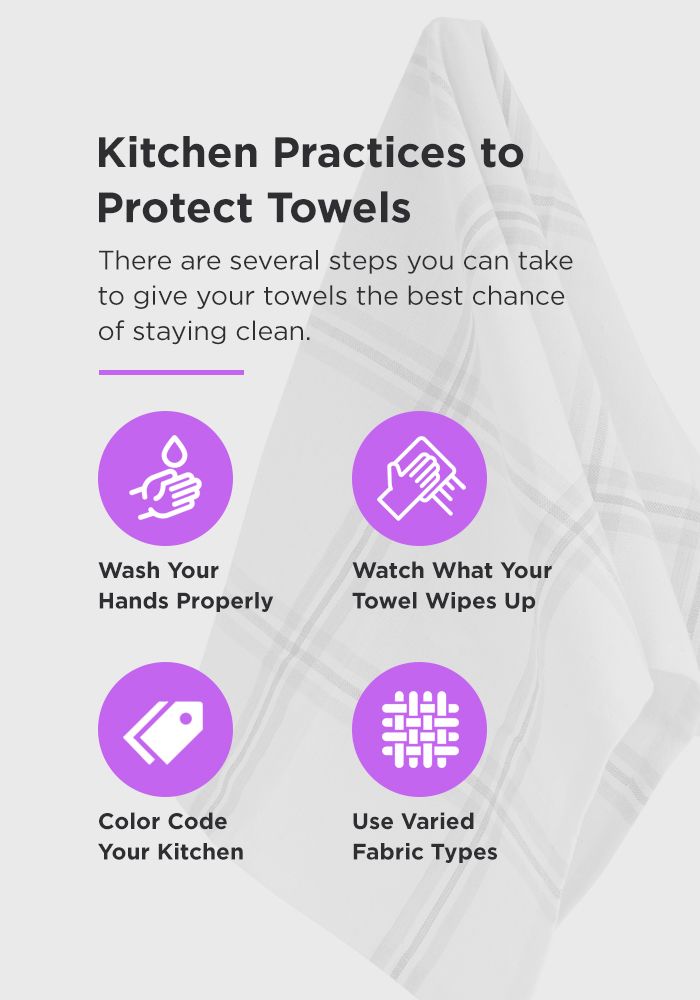
If you're using your towel to clean up raw meat, fish or egg messes or to wipe unwashed hands after handling any of those products, you're exposing the towel to dangerous bacteria. When a towel isn't washed after it's been exposed, you run the risk of potential food poisoning.
In some scenarios, it may be safest to reach for a disposable paper towel. Tossing the paper towel after cleaning the mess helps decrease your chances of spreading bacteria, especially if you don't throw your reusable towel into the kitchen wash right away.
3. Color Code Your Kitchen
The kitchen towel study indicated that using towels for a variety of purposes increased their chances of growing harmful bacteria. Designating specific towels for different purposes can help cut down on cross-contamination — if you can keep them straight. When you're in a time crunch, the last thing you want to do is stop and try to remember which towel is for which task.
Color coding your kitchen towels will send clear reminders to your brain. Select colors to match your preferences or kitchen, and then divide them up.
Here's an example of a color-coded kitchen towel system:
- Color 1: Use to dry hands after washing
- Color 2: Use to wipe and dry countertops
- Color 3: Use to dry dishes and utensils
If possible, to avoid confusion place your towels near the area of the kitchen you'll be using it in — whether the sink, stove or counter.
You don't have to stick to solid-colored towels when you're color coding. Select towels with different colored stripes or different colored patterns to mix things up. If the towel code remains distinct, the mixing and matching possibilities are endless.
4. Use Varied Fabric Types
In addition to color coding, incorporating a mix of cotton and microfiber towels can help you distinguish which cloth is used for each task. Beyond avoiding cross-contamination, this practice can help keep your cleaning and drying safe and effective.
When pairing a towel-type to each task, consider the different fabric properties:
- Cotton Towels: A staple for kitchen towels, cotton is absorbent, fluffy and affordable. Cotton towels are easy to wash and they're breathable, but they tend to take longer to dry than microfiber. Prolonged towel dampness could contribute to bacteria growth if the towel isn't hung in a dry environment. Given a cotton towel's makeup, it may be best used to dry your hands after you've washed them.
- Microfiber Towels: Microfiber's dense fibers make it great for soaking up messes. It's lightweight, durable and it packs a lot of cleaning power. In addition, microfiber towels dry quickly — which helps beat bacteria growth. It's important to note the tightly-packed fibers that pick up small particles may catch at small imperfections and cause discomfort if you have sensitive skin. While this type of cloth is a powerful cleaning tool, it may not be the best choice for everyone. Because of their cleaning ability, microfiber towels are great for wiping down kitchen countertops or quickly drying dishes and utensils.
By introducing variation into your towel line up, you'll be able to grab the towel you're looking for as quickly as possible. And when you choose a fabric designed for the task at hand, your work in the kitchen will be even more efficient.
How Often Should You Clean Your Kitchen Towels?
Once you've protected your kitchen from spreading bacteria by not using the same towel over and over for several days, consider how often you should wash your kitchen towels. As mentioned in the study, several factors will influence your washing frequency. Do you use your towels for a single purpose, or for every task around the kitchen? Are there children, elderly adults, those with allergies or those with weak immune systems in your household? If yes, you'll want to wash your towels frequently.
Another factor to consider is the material your kitchen towel is made of. If you're using microfiber towels to soak up messes, you may want to wash them more frequently than cotton towels. Microfiber towels are built to be absorbent and trap small particles and liquid. While this is great for removing bacteria from counters, it also means your microfiber towels may hold onto excess germs.
Laundering your towels regularly is a good practice. Here are some other general practices that can keep you safe and your towels fresh.
Best Practices for Towel Washing
You want to keep your towels clean, but you don't want to spike your water bill with endless cycles of laundry or to wash one towel at a time. Keep your kitchen laundry separate from your other household wash, and for efficiency, wash all your kitchen laundry together in a weekly or twice weekly load — depending on your usages throughout that week.
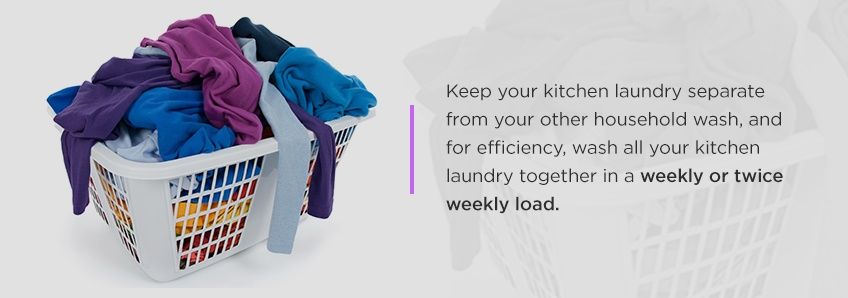
Here are some other tips to consider when it comes to washing your kitchen towels:
- Increase kitchen airflow: Switching on a fan in your kitchen will help avoid excess moisture in your kitchen towels. The drier the towel, the less likely you'll have bacteria growth.
- Wash when visibly soiled: Change out your towels when they are visibly stained. This tactic prevents you from smearing last night's dinner on the counters again and will help you avoid bacteria.
- Wash when it smells: If your kitchen towel has a musty odor, it might have bacteria or mold growth. Grab a new towel and wash the smelly one to keep your kitchen clean and safe.
- Keep in mind sickness: If someone in your household is sick, wash your kitchen towels frequently. Germs on countertops can easily end up on kitchen towels. To keep everyone healthy, launder kitchen towels often.
- Let it dry: Before you throw your kitchen towel into the laundry basket, make sure it's completely dry. A damp, bacteria-filled cloth will likely grow smelly and spread bacteria to nearby cloths if it sits for a while before being washed.
- Wash with hot water: Choosing a warm or hot water cycle will help kill bacteria and sanitize your kitchen towels. If you frequently use your kitchen towels, this is especially important.
- Avoid fabric softener: Over time, fabric softener can leave a coating on kitchen towel fibers. This decreases the towel's effectiveness, making it more likely that you may leave germs on countertops. Leave the fabric softener out to keep your towels strong and absorbent.
If your kitchen sees a lot of activity during the day, odds are your towels do too. Switching out your kitchen towel every day may help prevent sickness and keep your kitchen germ-free.
Find Your New Kitchen Towels at Towel Super Center
Whether you use your kitchen towels residentially or commercially, Towel Super Center has a product for you. Our cotton and microfiber kitchen towels come in a variety of sizes and colors, allowing you to purchase the towels you need for the task at hand. Buying in bulk with wholesale prices means you'll never be without a clean kitchen towel. Our durable towels won't break down or lose absorbency after repeated washes, which means you can save money while keeping your kitchen clean.
Towel Super Center offers quality towels for every need. If you're looking to stock your kitchen, shop our selection of wholesale towels today.




